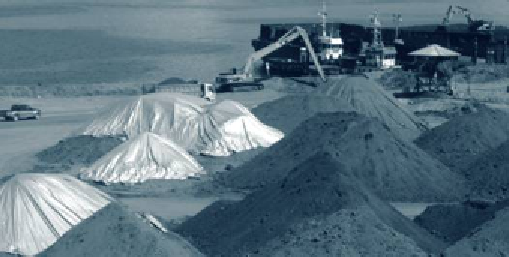Environmental Engineering Reference
In-Depth Information
TABLE 20.2
Dispersion by Wind Erosion of Mine Waste Particles from Storage Facilities and Common Prevention Options (EC 2004)
Solid may be dispersed by
Prevention
Wind erosion of the surfaces of the impoundment
structure, such as:
●
crest of dam/heap
●
slopes of dam/heap
●
surface of tailings beaches
●
dam crest and slopes may be treated in the same manner as for the prevention of water
erosion
●
surfaces may need wind breaks, water spray, application of binding material, i.e. spraying
with bituminous emulsion, surface mulch, lime slurry
●
in extreme cases tailings may have to be deposited under water
●
surface vegetation, either fl oating or on inactive areas
●
frequent change of tailings discharge points around perimeter to achieve a continuous
and constantly wet surface
but the cover inhibits the maturation of the tailings deposits. The technology to apply these
on very soft but maturing tailings is expensive to develop and to operate (EC 2004).
Besides tailings storage areas there are many other sources of fugitive dust emissions
that may be carried away with prevailing winds. Fugitive dust can originate from site
preparation (e.g. land clearing, soil stripping and topsoil management), mining operations
(e.g. drilling and blasting), transportation - probably the most common source of con-
tinuous dust emissions (e.g. from loading equipment, haul vehicles, conveyors), commi-
nution (crushing and grinding), and mine waste management operations (i.e. waste rock
dumping).
During day-to-day mining operations, wind erosion control or dust control consists
mostly of applying water or other dust palliatives as necessary to prevent or alleviate dust
nuisance generated by mining, transport and storage activities. Covering small stockpiles
or areas is an alternative to applying water or other dust palliatives (
Case 20.1
).
Dust controls generally focus on (1) stabilizing exposed surfaces and (2) minimizing
activities that potentially suspend dust particles (
Table 20.3
)
. For heavily trafi cked areas
such as haul roads and for disturbed areas (e.g. land clearing areas), wet suppression
(watering), chemical dust suppression, gravel or asphalt surfacing, and equipment wash-
down areas can be employed as dust control measures. Permanent or temporary vegetation
CASE 20.1
Judicious Application of Water for Dust Suppression
Dust control may not be the main objective
for covering stockpiles. Managing moisture
content in the mined product may be more
important. The cost of a 1% moisture
increase in shipped ore can amount to sev-
eral hundred thousand dollars per shipment,
due to the increased cost of shipping the
additional mass plus the reduced value of
product to the purchaser. The composition
of the shipped mine product is carefully
analyzed by both mining operator and
receiving mineral processing facility. This
makes for interesting discussions if port
facilities apply water for dust control,
or for quarantine purposes as is com-
mon at Australian ports. Water spraying
commonly affects the same surface
materials from which control samples
are taken by the processing facility.












Search WWH ::

Custom Search